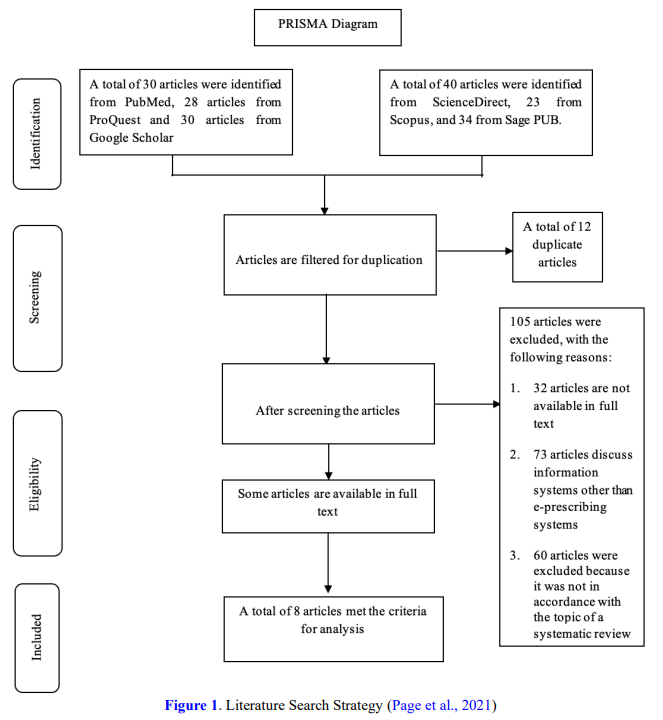Main Article Content
Abstract
The electronic prescribing system has a good role in health services with the powerful features that this system has, when compared to manual prescribing. This systematic review aims to determine the role of the electronic prescribing system in health services. The literature search was conducted from 21 November 2022 using PubMed, ProQuest, Google Scholar, ScienceDirect, Scopus, and Sage PUB as literature search area databases. A literature search strategy using BOOLEAN Operator to help specify the search terms. Literature search based on inclusion criteria. After eliminating duplication, title, abstract and full text, 8 articles were obtained for analysis. The electronic prescribing system has a good role in health services, including reducing medication errors, improving the quality of communication and information both between staff and staff and patients, shortening service time, having an alert system that is able to detect allergies, drug interactions, and adverse drug reactions. desired, time and cost efficiency, effectiveness in terms of patient safety, providing satisfaction for users because with these qualified features they can help in terms of service when compared to manual prescriptions. Further research should be conduct to review the role of Clinical Decision Support System and the electronic Health Record in healthcare due to its limitation.
Keywords
Article Details

This work is licensed under a Creative Commons Attribution-NonCommercial 4.0 International License.
References
- Ababneh, M. A., Al-Azzam, S. I., Alzoubi, K. H., & Rababa’h, A. M. (2020). Medication errors in outpatient pharmacies: comparison of an electronic and a paper-based prescription system. Journal of Pharmaceutical Health Services Research, 11(3), 245–248. https://doi.org/10.1111/jphs.12356
- Almutairi, B. A., Potts, H. W. W., & Al-Azmi, S. F. (2018). Physicians’ perceptions of electronic prescribing with electronic medical records in Kuwaiti primary healthcare centres. Sultan Qaboos University Medical Journal, 18(4), e476–e482. https://doi.org/10.18295/squmj.2018.18.04.008
- Belcher, W. L. (2009). Writing Your Journal Article in Twelve Weeks. SAGE Publications.
- Farghali, A., Borycki, E. M., & Macdonald, S. (2021). Pharmacist’s perception of the impact of electronic prescribing on medication errors and productivity in community pharmacies. Knowledge Management and E-Learning, 13(4), 536–558. https://doi.org/10.34105/j.kmel.2021.13.029
- Fortunate Business Insight. (2022, December). E-prescribing Market Size, Share, Growth & Global Report, 2026. Fortunate Business Insight. https://www.fortunebusinessinsights.com/e-prescribing-market-102698
- George, P., Decastro Molina, J., & Heng, B. (2014). The methodological quality of systematic reviews comparing intravitreal bevacizumab and alternates for neovascular age related macular degeneration: A systematic review of reviews. In Indian Journal of Ophthalmology (Vol. 62, Issue 7, pp. 761–767). Medknow Publications. https://doi.org/10.4103/0301-4738.138615
- Hindmarsh, J., & Holden, K. (2022). The electronic prescribing of subcutaneous infusions: A before-and-after study assessing the impact upon patient safety and service efficiency. International Journal of Medical Informatics, 163. https://doi.org/10.1016/j.ijmedinf.2022.104777
- Hinojosa-Amaya, J. M., Rodríguez-García, F. G., Yeverino-Castro, S. G., Sánchez-Cárdenas, M., Villarreal-Alarcón, M. Á., & Galarza-Delgado, D. Á. (2016). Medication errors: electronic vs. paper-based prescribing. Experience at a tertiary care university hospital. Journal of Evaluation in Clinical Practice, 22(5), 751–754. https://doi.org/10.1111/jep.12535
- Joanna Briggs Institute. (2022). JBI Critical Appraisal Tools. Joanna Briggs Institute. https://jbi.global/critical-appraisal-tools
- Kõnd, K., & Lilleväli, A. (2019). E-PRESCRIPTION SUCCESS IN ESTONIA: THE JOURNEY FROM PAPER TO PHARMACOGENOMICS. In National success in digital health Eurohealth (Vol. 25, Issue 2).
- Lau, G., Ho, J., Lin, S., Yeoh, K., Wan, T., & Hodgkinson, M. (2019). Patient and clinician perspectives of an integrated electronic medication prescribing and dispensing system: A qualitative study at a multisite Australian hospital network. Health Information Management Journal, 48(1), 12–23. https://doi.org/10.1177/1833358317720601
- McCulloch, A., Sarwar, A., Bate, T., Thompson, D., McDowell, P., Sharif, Q., Sapey, E., & Seccombe, A. (2020). Electronic-prescribing tools improve N-acetylcysteine prescription accuracy and timeliness for patients who present following a paracetamol overdose: A digital innovation quality-improvement project. DIGITAL HEALTH, 6, 205520762096504. https://doi.org/10.1177/2055207620965046
- Mills, P. R., Weidmann, A. E., & Stewart, D. (2017). Hospital staff views of prescribing and discharge communication before and after electronic prescribing system implementation. International Journal of Clinical Pharmacy, 39(6), 1320–1330. https://doi.org/10.1007/s11096-017-0543-2
- Mohsin-Shaikh, S., Furniss, D., Blandford, A., McLeod, M., Ma, T., Beykloo, M. Y., & Franklin, B. D. (2019). The impact of electronic prescribing systems on healthcare professionals’ working practices in the hospital setting: A systematic review and narrative synthesis. BMC Health Services Research, 19(1). https://doi.org/10.1186/s12913-019-4554-7
- Page, M. J., McKenzie, J. E., Bossuyt, P. M., Boutron, I., Hoffmann, T. C., Mulrow, C. D., Shamseer, L., Tetzlaff, J. M., Akl, E. A., Brennan, S. E., Chou, R., Glanville, J., Grimshaw, J. M., Hróbjartsson, A., Lalu, M. M., Li, T., Loder, E. W., Mayo-Wilson, E., McDonald, S., Moher, D. (2021). The PRISMA 2020 statement: An updated guideline for reporting systematic reviews. In The BMJ (Vol. 372). BMJ Publishing Group. https://doi.org/10.1136/bmj.n71
- Porterfield, A., Engelbert, K., & Coustasse, A. (2014). Electronic prescribing: improving the efficiency and accuracy of prescribing in the ambulatory care setting. Perspectives in Health Information Management, 11(Spring), 1g.
- Raeesi, A., Abbasi, R., & Khajouei, R. (2020). Evaluating physicians’ perspectives on the efficiency and effectiveness of the electronic prescribing system. In International Journal of Technology Assessment in Health Care. Cambridge University Press. https://doi.org/10.1017/S0266462321000052
- ReportLinker. (2022). GlobeNewswire News Room. E-Prescribing Global Market Report 2022. https://www.globenewswire.com/news-release/2022/09/07/2511747/0/en/E-Prescribing-Global-Market-Report-2022.html
- Roumeliotis, N., Sniderman, J., Adams-Webber, T., Addo, N., Anand, V., Rochon, P., Taddio, A., & Parshuram, C. (2019). Effect of Electronic Prescribing Strategies on Medication Error and Harm in Hospital: a Systematic Review and Meta-analysis. In Journal of General Internal Medicine (Vol. 34, Issue 10, pp. 2210–2223). Springer New York LLC. https://doi.org/10.1007/s11606-019-05236-8
- Stoll, C. R. T., Izadi, S., Fowler, S., Green, P., Suls, J., & Colditz, G. A. (2019). The value of a second reviewer for study selection in systematic reviews. Research Synthesis Methods, 10(4), 539–545. https://doi.org/10.1002/jrsm.1369
- Teferi, G. H., Wonde, T. E., Tadele, M. M., Assaye, B. T., Hordofa, Z. R., Ahmed, M. H., & Hailegebrael, S. (2022). Perception of physicians towards electronic prescription system and associated factors at resource limited setting 2021: Cross sectional study. PLoS ONE, 17(3 March). https://doi.org/10.1371/journal.pone.0262759
- The University of Texas. (2022). Systematic Reviews. The University of Texas. https://libguides.sph.uth.tmc.edu/SystematicReviews/InclusionAndExclusion
